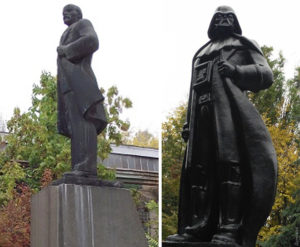In October 2015, following the passage of an anti-communism law in Ukraine, a Vladimir Lenin statue turned into Star Wars’ Darth Vader overnight. De-communist measures have long been synonymous with America’s pop culture missionary work. This image was a reminder that the aggressive-style political realism practiced by the Putins of the world has been outstripped by cosmetic triumphs and entertainment competencies. Similar moments mark the post-Cold War as we come to grips with American transmedia and aesthetic Catholicism. Historically speaking, America can be compared to the Sacrum Imperium of medieval Christianity with the key difference being our rituals and technologies are dominated by an aesthetic, not a religious hegemony. Many of the symbols of medieval Europe offer analogous ways we can think about the evangelical spirit in our own times.
Americans not only act as the authority of global media, but the social fabric of America is astoundingly aesthetic. Americans know more about and consume pop culture than anything else, since everything is filtered through its tropes and forms. Where else does the media, police, or our community leaders look to get informed today other than on these transmedia apps and platforms? The indulgence in entertainment and digital imaging brings forth a kind of pious devotion, which mirrors religious zealousness. Religious and aesthetic truths operate in the same cutthroat manner—no truly notable distinction exists between social persecution in the form of social media scandals, Galileo trials, or witch hunts! Celebrities are the deities of our age, so everyone is pressured to preform virtually as a quasi-star; generating click-bait and imitating “covers” by the millions. To be famous and successful means to be among the pantheon of the gods or called into worldly sainthood. However, the performance of this pastoral service relies less on selflessness and has more to do with self-promotion. America’s Church of Aesthetics stipulates that one must not sacrifice all of their worldly possessions, but should work to gather and increase them. Such symbols of “divine favor,” as the Puritans called them, are just as much for the purposes of showing off as they are meant to save the world. In religious terms, the ideal of truth has been supplanted for what is deemed attractive and interesting. When you think of Scientology, for example, ask yourself if it is more concerned with religion or the cosmetics of playing the role of religion in order to get its tax-exempt status? No wonder then that its leading faces and spokespeople are the shining stars in the holy circles of Hollywood that all well-meaning aesthetes envy. Scientology has nothing to do with neither religion nor science, but is the brainchild of aesthetic contrivances, with vulgar pragmatic appeal.
Perhaps it may be fair to say that western churches did not stop at Saint Peter basilica or Massachusetts Bay, but continued west to Hollywood and Silicon Valley. These megalopolises of image transmission and techno-gnostic gadgetry serve as the center for global broadcasting maintenance. Just as the Church interrogated heathen lands in search of lost souls and miracles, Americans serve as the missionaries ready to recruit and ordain the next stage or field star, talent, or viral sensation. Computer tech and social media companies serve today as the current meta-dispatchers of the world—the new popes and queens of pop culture! Spirit can now be found in the glow of the humming screen.
Aesthetic-religion teaches the lessons of salvation and damnation in our lives, through its rituals of movies, music, sports, and social media. Our devices act as a kind of new digital Bible. Similar to the moods of imperial Christianity, access to Google and other top search engines provide the new “faithful” with all of their “answers,” which it is deemed a sacrilegious to question. How different are we really from a medieval European who carries around his or her “book,” with its scriptural apps and guides for worldly and heavenly navigation? Whether it is a Gutenberg bible from the fifteenth century or an iPhone of the twenty-first makes no difference—both bring the Gospel or “good news” from afar. The functional differences and nuances between oral, print, and digital media are viewed as secondary in relation to divine telecommunications. Presupposed in the long-distance phone call or Skype session of today is the structure of the prayer or angel’s (messengers) appearance, who shows up and provides or reaches out.
From the aesthetic standpoint, conflicts between western nations and Islamic jihadists reflect the schism between the oriental and occidental orthodoxies. Both sides are committed to win the war of images or sacraments and to administer them at the altar of entertainments. The recruiting successes of ISIS attest to the power of media production and its overwhelming charm regardless of how foreign the message or messenger may be! Americans easily can recognize that the victories of terrorism lie less in the desire to erect a caliphate and have more to do with the allurement of show business. By securing the apparatus necessary to effectively manipulate mass psychology and social media, the devilish trickster mentality of “two can play that game” is likely to continue. Terrorist networks have established their own Church of Aesthetics that seeks to outdo the American horror art genre by capturing more concisely that sublime nature of the divine power through diabolical works of art of which 9/11 is the first. Likewise, what is the difference between the terrorist’s testimonial video and a loved one’s will if they engaged in the same ritual? In a post-McLuhanian world of American aesthetic Catholicism, the medium makes all the difference and determines the meaning of the message, not the messenger! Similar to the angel or Godhead, our media today allows the messenger to remain a mystery–who is behind the text or profile? In this sense, our age practices a kind of estrangement from the divine because we no longer believe in the strong sender. Who we can put our faith in virtual neo-representatives? Virtual representations are unreliable. As Nietzsche announced, we live in an age that desperately seeks strong senders but struggle to find any. The “madman” is now running around cyberspheric media echo chambers feeling compelled to lash out and bite the hand that feeds him.
America and its enemies tap into the same cyber techniques and strategies to deal with all aspects of cultural consciousness. Everything from the filming and posting of TV reporters being murdered to viral confessionals of personal tragedies, or public apologies from officials and companies have all been thoroughly aestheticized. It is all about the performance and escalation of self-design! Design and performance have become the bread and wine of America’s cultural experimental communion! The ethics of the day is nothing less than what may be called a Cosmetica Moralia. Even the dignity of the US presidency has been turned into an ironical exhibition of epic proportions. America finally has a president unabashedly willing to admit that names on buildings, re-branding campaigns, and TV ratings far outweighs substantive policy concerns. For example, former FBI director James Comey will be testifying on Capitol Hill this week about presidential obstruction of justice and the Russian fetish, while the magnitude of the event itself is being compared to “Washington’s Super Bowl.” Beyond the erosion of public trust or the seriousness of corruption charges, the forty-fifth administration’s continued debacle and daily reality-TV serve as big theater. It should be no surprise that the bars will be open all day around the nation, as the difference between the political and the performative athlete or entertainment consultant continues to blend and fad on the big screens in front of us.
On a positive note, entertainment displays a sort of “saving power” in the prevalent narratives of American success and opportunity because, as the brilliant American philosopher Susanne Langer contends, “we give ourselves up to their contemplation, eagerly, without any other intent than to bear and see and be enthralled.” American aesthetic Catholicism aims to create a growing enthusiasm for the ways in which minorities and other voices of the unheard are at the frontier of music, sports and so on. This entertaining semblance of inclusiveness has sustained a hope and healing symbolism, which gives a divine aura to American identity around the globe. Such cultural matrices promote a wider nexus of possible identities and give the impression of a less estranged and alienated people. We may not be in good shape politically, economically, or militarily, but we can express our frustrations aesthetically and point to the very acts of articulated irritation–it is not merely banter or trivial gossip–as fundamental to personal and social freedom. As meta-dispatchers, everyone is fulfilling Martin Luther’s vision today. We all act as the clergy of our times to whom a confessional must be given. Philosophers, scientists, politicians, and even wise popes have long known that truth no longer matters without hitting the presses or without making my newsfeed! Transmedia as infotainment and edutainment is neither liberal nor conservative, real nor hoax, rather it is our national pastime enacted as a new faith and religion. Each of us is now expected to attend this service, under the roof of a grand global media saloon that treats all things mundane and holy with aesthetic zest and prowess.








